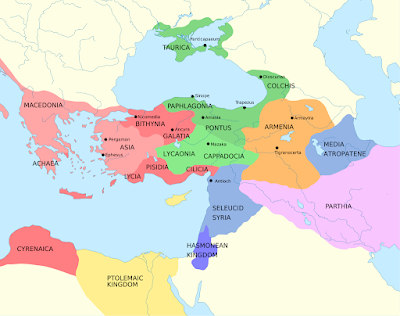Omgzi's blog
Our Father who art in heaven,hallowed be thy name. Thy kingdom come. Thy will be done on earth as it is in heaven. Give us this day our daily bread,and forgive us our trespasses,as we forgive those who trespass against us, and lead us not into temptation,but deliver us from evil. For thine is the kingdom, and the power, and the glory, for ever and ever. Amen.
Sunday, March 9, 2025
Monday, February 17, 2025
Ancient Israel House : 1st Century Nazareth House
 |
| a house from the 1st century AD was discovered in Nazareth, 2009 |
 |
| example of a stone house with courtyard |
Features of a house in 1st century Nazareth
Houses in Nazareth had a flat roof with exterior stairs at
the side and an awning of woven goats’ hair to protect against the sun. This
was used by the women as a work-space, an extra room.
The roof was also a cool place to sleep in hot weather.
The walls were covered with plaster, rubbed flat with a
stone and painted with geometric patterns.
There was hardly any furniture. Niches were cut into the
wall, and these provided storage for bedrolls and clothes.
Large amounts of food – jars of oil and olives, etc., were
kept in separate storage areas, secure against mice. Archaeological excavations
in the Nazareth area show there was a honeycomb of underground rooms under the
houses, hollowed out of the soft rock. They were used for a variety of purposes
– living quarters in the fierce heat of summer, cisterns for water, grain
silos, and storage.
The inside rooms of the house were small and dark, so the
courtyard and roof were important work areas, with better light for tasks like
spinning and weaving.
Down in the courtyard was the cooking area, with an open fire, an oven and an array of cooking utensils. There was a mortar and pestle for grinding small amounts of grain and a covered area where people sat while they worked or talked.
Courtyard served as a daily workplace – the weather was dry
for most of the year. Here Spinning and weaving were done, food was prepared,
people met, and animals were kept.
The courtyard often contained a mikveh for ceremonial
purification, and the family latrine as well, which was emptied every day into
a communal manure pit.
Ancient Israel House : Iron Age's Four Room House
A four-room house, also known as an "Israelite house" or a "pillared house" is the name given to the mud and stone houses characteristic of the Iron Age of Levant.
 |
| The house is about 7.5 meters by 6.8 meters |
 |
| many four-room houses were at least partially two stories |
 |
| Hundreds of four-room houses are known today from Iron Age sites mainly concentrated in the highlands (i.e. the Galilee), the Central Hill Country and the Transjordanian Plateau |
Sunday, February 16, 2025
Herodian Kingdom
Saturday, December 28, 2024
Sunday, October 6, 2024
1854 委辦譯本
19世纪中叶前,西方传教士的活动范围受限于当时满清政府的政策,主要局限在澳门、广州的小部分区域和海外华人侨居的地方。
1842年,满清政府签订《南京条约》,割让香港给英国治理,并开放上海、厦门、福州、广州和宁波五处港口,进行贸易通商。也为新教传播开辟了新局面。
1843年,英美两国的5个差会(伦敦会London
Missionary Society、美部会Congregational
Church、马礼逊教育会、美国浸礼会American
Baptist Churches、美国长老会)的代表,在香港首次召开以共同翻译中文圣经为目的的传教士会议,并成立一个译经委办会。会议决定,以「公认经文」(Textus
Receptus)作为希腊文基础文本,修订当时的新约译本,并且重新翻译旧约。
5个差会的代表成員包括:
裨治文 (Elijah
Coleman Bridgman 1801-1861 ) - American Board of Commissioners for Foreign Missions、
文惠廉 (William Jones Boone 1811-1864 ) - Protestant Episcopal Church Mission、
克陛存 (Michael
Simpson Culbertson 1819-1862 ) - American Presbyterian Mission 、
婁理華 (Walter
Macon Lowrie 1819-1847) - American Presbyterian
Mission、
高德(Josiah
T. Goddard 1813-1854 ) - Baptist Board for Foreign Missions、
羅爾悌 (Edward
C. Lord 1817-1887 ) - American Baptist Missionary Union、
迪因修 (William
Dean 1807-1895) - American Baptist Missionary Union、
施敦力 (John
Stronach 1810-1888) - London Missionary Society、
理雅各 (James
Legge 1815-1897 ) - London Missionary Society、
麥都思 (Walter
Henry Medhurst 1796-1857 ) - London Missionary Society、
美魏茶 (William
Charles Milne 1815-1863 ) - London Missionary Society、
另由中國人王韜 (Wang Tao 1828-1897 ) 潤筆。
1844-1847年 : 第一阶段
译本分由五个传教驻区(上海/宁波、厦门、福州、曼谷、广州/香港)的委员会各自负责翻译。各个驻区的委员会把译文呈送到其他的地区进行修改,修改后的原稿再送回委员会,最后呈交到委办大会定稿。在这四年间,由于种种原因,例如参与翻译的两位传教士相继离世,翻译过程中出现译名的分歧,以及传教士忙于其他传教事务等原因,原先拟定的计划和地区经历数次的变动,翻译的进度较慢,成果不多。
1848-1850年 : 第二阶段
工作进度依然十分缓慢,平均每天10节经文的进度。在这个阶段,翻译工作主要由麦都思、裨治文、施敦力和美魏茶等人负责。
1850年,完成《新約》的翻译。
1852年,翻譯過程中,譯者們對用「上帝」還是用「神」各執己見。
美國聖經公會 (American Bible Society) 採用「神」,名《救世聖經》
英國及海外聖經公會 (British and Foreign
Bible Society, 前稱大英聖書公會)
採用「上帝」,
印行兩種版本《新約》。
1853年,倫敦會的麥都思、施敦力、米憐等人退出委員會,自行完成修訂《舊約》。
1854年,《舊約》譯本與委員會所譯《新約》以《代表譯本聖經》為名合訂出版,由英國及海外聖經公會出版,史稱「代表譯本」或「委辦譯本」(Delegates’
Version)。
1857年,麥都思、施敦力出版以南京官話(白話文)改寫的文言「委辦譯本」的新約全書,是中國第一本白話文譯本,史稱「麥都思、施敦力譯本」或「南京官話譯本」。
1859年,裨治文、克陛存和文惠廉翻譯,由美國聖經公會出版文言文(深文理)新约。
1862年,裨治文、克陛存和文惠廉翻譯,由美國聖經公會出版文言文(深文理)旧约。
Friday, September 27, 2024
1826 救世主耶稣新遗诏书
郭实腊文理译本,是马礼逊译本出现之后、委办译本问世之前的一个文言文译本,又称四人小组译本,因有四人参与,分别是:
麦都思(Walter Henry Medhurst,1796-1857)、
郭实腊(Karl Friedrich August Gützlaff,1803-1851)、
裨治文(Elijah Coleman Bridgman, 1801-1861)、
马儒翰(John Robert Morrison,1814-1843)。
马礼逊(Robert Morrison)在1834年去世之后,麦都思等人开始着手修订马礼逊的文理译本,但最后的译本则是全新的译本。
1835年,修订神天圣书的四人小组成立。
1837年,修订新约,取名《新遗诏书》。
1840年,修订旧约,取名《旧遗诏书》。
1840年,郭实腊修订的《救世主耶稣新遗诏书》。
1853年,太平天国删印《救世主耶稣新遗诏书》,易名为《新遗诏圣书》。
1860年,太平天国再印圣经。《旧遗诏圣书》和 《新遗诏圣书》分别易名为 《钦定旧遗诏圣书》和《钦定前遗诏圣书》。











.png)




.jpg)

.jpg)